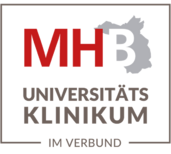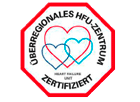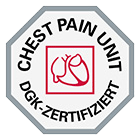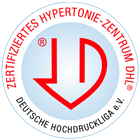Aortic aneurysm
Aortic aneurysms develop when the wall of the aorta weakens, resulting in part of the aortic wall bulging outwards. Patients with aortic aneurysm can remain symptom-free for a long time. However, the affected section of the aortic wall may become over-stretched and rupture - leading to a life-threatening situation. As a result of this, treatment usually consists of preventative surgery.
What is an aortic aneurysm?
The term aortic aneurysm refers to a stretched and bulging section of the aorta. Aortic aneurysms are the result of a weakening of the aortic wall exacerbated by a hardening of the arteries (atherosclerosis) and high blood pressure. The condition particularly affects older men.
Aneurysms can occur both in the chest area (thoracic aortic aneurysms) and in the abdomen (abdominal aortic aneurysms). The aorta's normal diameter is between 3 and 3.5 cm wide. Once the aorta has been stretched to more than 5 or 6 cm, it is at risk of dissection (a tear in the inner wall), or even rupture.
What are the main symptoms?
Aneurysms, in particular smaller ones, often do not cause symptoms and, as a result, may only be found by chance. Larger aneurysms, however, may cause symptoms, with the exact nature of these symptoms depending on the location of the aneurysm:
- Abdominal aortic aneurysms: these may cause abdominal and back pain, and may even cause digestive problems.
- Thoracic aneurysms - these can be associated with chest pain, coughing, hoarseness, difficulty swallowing, and shortness of breath.
- A ruptured thoracic aortic aneurysm is often associated with acute pain in the chest or abdomen, nausea and vomiting, and even circulatory collapse (shock).
What are possible causes?
When sections of the aorta stretch and bulge, this is a result of a weakening of the aortic wall. As we get older, the aortic wall loses its elasticity, making it less able to withstand the pressure of the blood inside the arteries. Important factors that help aneurysms to develop include:
- Hardening of the blood vessels (atherosclerosis)
- High blood pressure
Diagnosis of aortic abdominal aneurysm
Sometimes, an aortic aneurysm may be found during medical tests ordered for a different reason. In thin people, it is sometimes possible for the physician to palpate the abdominal aortic aneurysm during an abdominal examination. More targeted diagnostic steps will then include:
- Ultrasound examination
- Computer-assisted tomography (CT) or Magnetic resonance imaging (MRI): These types of scans will provide additional information on the shape and size of the aneurysm.
- In addition to the above, the physician may also choose to obtain an image of the inside of the blood vessel (angiogram).
Treatment for aortic aneurysm
Although emergency surgery to repair a ruptured aneurysm carries a very high risk, preventative surgery performed by an experienced surgeon is often associated with a very low risk to the patient. As a result, preventative treatment is usually the preferred option, particularly in cases where the aneurysm is greater than 5 or 6 cm in diameter.
Treatment for aortic aneurysm usually involves open surgery or catheter-based procedures.
Open vascular surgery
Open vascular surgery is usually necessary when the thoracic aneurysm is located in a section of the aorta that is close to the heart (ascending aorta and aortic arch).
If the aneurysm is of moderate size, a simpler type of procedure - which involves placing an endovascular stent graft inside the aneurysm - may suffice. It may even be possible for an endovascular stent graft to be performed as part of a different procedure, e.g. while a patient is undergoing valve replacement surgery.
In most cases, however, it will be necessary to perform prosthetic remodeling of the aorta, a procedure that involves replacing the weakened section of the aorta with a prosthetic tube. As this type of surgery requires an interruption of the blood flow, a heart-lung machine (cardiopulmonary bypass - CPB) is used. Blood returning to the heart is diverted to this machine through a system of tubes. Once inside the machine, the blood is oxygenated before being returned to the body.
If surgery involves replacement of the section of the aorta from which the carotid arteries arise, the CPB machine is also used to cool the blood to 18 degrees Celsius. This slows down the body's metabolism in a way that could be likened to a state of hibernation, thus protecting even the brain against a temporary disruption in the normal blood supply.
Endovascular (catheter-based) surgery
While certain types of thoracic aneurysms are suitable for catheter-based (endovascular) surgical procedures, this type of procedure is particularly useful in patients with abdominal aortic aneurysm. Compared to open surgery, endovascular repair is significantly less invasive, and causes much less trauma to the patient.
Endovascular repair involves the physician inserting an endovascular stent graft through an opening in the blood vessels in the groin, and advancing it to the site of the aneurysm. The stent consists of a wire mesh tube covered in synthetic fibers, and is placed inside the aorta in such a way as to effectively exclude the aneurysm from normal blood flow.





